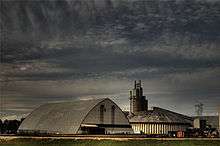Alberta's Industrial Heartland
Alberta's Industrial Heartland (also known as Upgrader Alley or the Heartland) is the largest industrial area in Western Canada and a joint land-use planning and development initiative between five municipalities in the Edmonton Capital Region to attract investment in the chemical, petrochemical, oil, and gas industries to the region.[1] It is "home to more than 40 petrochemical companies" and is one of Canada's largest petrochemical processing regions."[2] By July 2015 there was $13 billion invested in new industrial projects providing employment for 25,000 in the Alberta's Industrial Heartland.[3]

Geography
Alberta's Industrial Heartland (AIH) comprises 533 km2 (206 sq mi) of land split between the City of Fort Saskatchewan, Lamont County, Strathcona County, and Sturgeon County, as well as the 49 km2 (19 sq mi) Edmonton Energy and Technology Park in northeast Edmonton.[4] At a total size of 582 km2 (225 sq mi),[4] AIH is the largest geographic area in Canada dedicated to hydrocarbon processing.[1] The largest completed project to date is the Scotford Complex, which includes an upgrader, a refinery, and a railyard.
Membership
Alberta's Industrial Heartland Association (AIHA) was founded in 1998 by the City of Fort Saskatchewan, Lamont County, Strathcona County, and Sturgeon County.[5] The City of Edmonton became a member of AIHA in 2010.[5] The nearby towns of Bruderheim, Gibbons and Redwater are associate members of AIHA.[1][6]
Refinery Row (Edmonton)
Refinery Row refers to the concentration of oil refineries in west Sherwood Park,[7][8][9][10][11] Strathcona County, Alberta, just east of the city of Edmonton. The two main refineries in Refinery Row are the Strathcona Refinery (Imperial Oil),[12] and the Suncor Edmonton Refinery (Suncor Energy)[13] The other main refineries in the Edmonton area are also located in Strathcona County, in a separate concentration around Scotford, Alberta.
Air quality
In response to a request from to the Canadian Press, researchers from the University of California, Irvine released results of new air-quality tests in 2015 from Alberta's Industrial Heartland. The team visited the AIH in July 8 to 12, 2012, their third visit.[2] The peer-reviewed 2013 publication based on samples taken during their 2008 and 2010 visits, "found smog-causing chemicals at levels comparable to — and occasionally many times higher than — some of the world's largest cities and industrial complexes."[2] Although the new tests revealed that the spikes of concentrated toxic plumes were short-lived, Donald Blake, remarked that, "These are the kinds of numbers we don't see in Los Angeles... If this is something that is blowing at somebody's house, and they're getting five to 20 parts per billion of benzene at them all the time ... that starts to worry me."[2]
References
- "Who We Are". Alberta's Industrial Heartland Association. Retrieved October 14, 2011.
- Bob Weber (29 August 2015). "Toxic taint: Tests in Alberta industrial heartland reveal air-quality concerns". Canadian Press via Calgary Herald. Retrieved 30 August 2015.
- "Alberta's Energy and Innovation Ministers Visit Heartland Region" (PDF), Industrial Heartland, July 2015, archived from the original (PDF) on 2015-08-16, retrieved 30 August 2015
- "Where We Are". Alberta's Industrial Heartland Association. Retrieved 2011-10-14.
- "History". Alberta's Industrial Heartland Association. Retrieved 2011-10-14.
- "Project Status", Industrial Heartland, July 2015, retrieved 30 August 2015
- "Workers injured in Edmonton plant explosion out of hospital". CBC News. October 24, 2008. Retrieved 2010-01-26.
- "Mayor's speech". Strathcona County. October 17, 2007. Archived from the original on September 10, 2012. Retrieved 2010-02-02.
- J. Hall (September 12, 2007). "Work stoppages hit refinery row, oilsands". Edmonton Journal. canada.com. Archived from the original on 2011-06-04. Retrieved 2010-01-26.
- Lawrence Herzog (July 26, 2007). "The 1987 tornado was a turning point". Edmonton Real Estate Weekly. Archived from the original on March 8, 2012. Retrieved 2010-01-26.
- "Strathcona County 2008 Map" (PDF). Archived from the original (PDF) on 2012-02-23. Retrieved 2015-08-31.
- "Imperial Oil - Strathcona Refinery". Archived from the original on 2010-07-30. Retrieved 2015-08-31.
- Suncor - Refining and Marketing